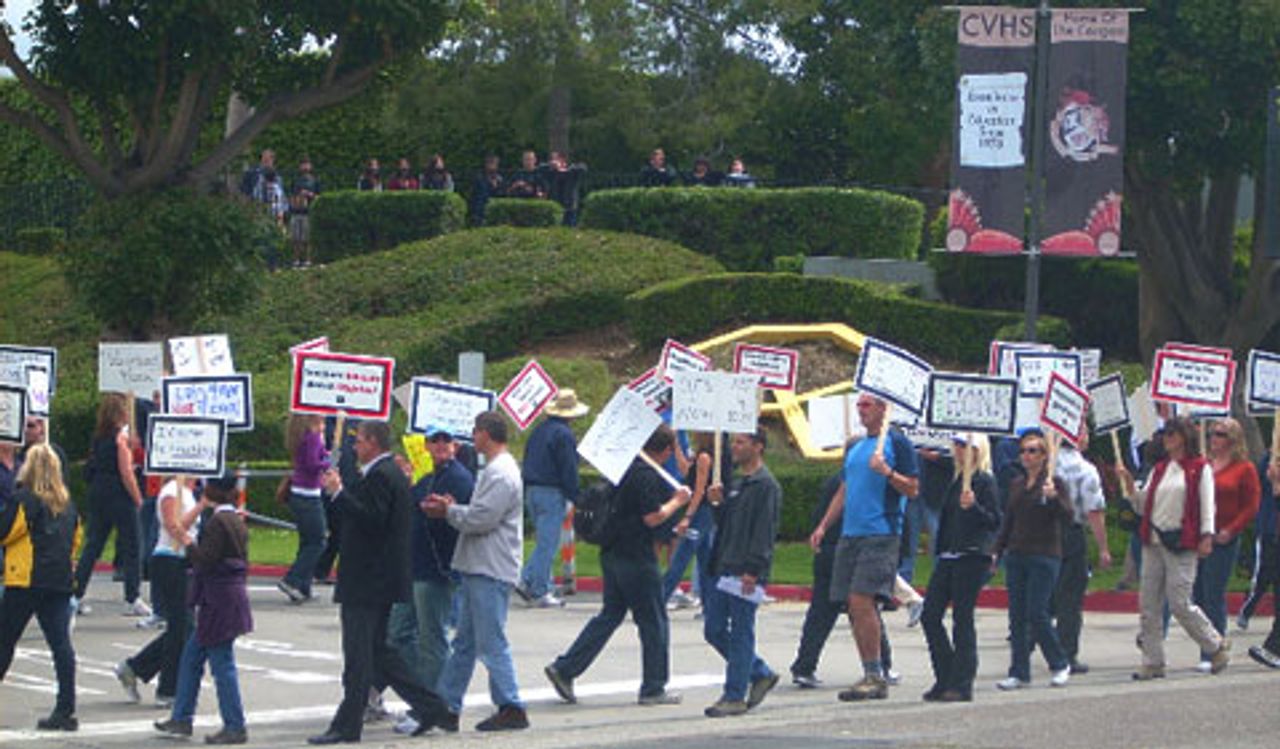 Picketing teachers at Capistrano Valley High School
Picketing teachers at Capistrano Valley High SchoolAn agreement reached between the Capistrano Unified School District (CUSD) and the Capistrano Unified Education Association (CUEA) ended a three-day teachers’ strike in San Juan Capistrano, California on Tuesday morning.
While the details of the contract have yet to be released, the local National Public Radio affiliate, KPCC, reports that the deal includes a combination of pay cuts, furlough days and increases to employee health care contributions.
The CUSD is the second largest school district in the Orange County area, which is south of Los Angeles, and the 12th largest district in the state. It employs 4,423 teachers and staff, making it the single largest employer in southern Orange County. The school system is facing a $34 million budget shortfall for the 2010-2011 academic year. District officials made it clear from the outset of budget negotiations that they intended to recoup $19 million in outlays by imposing wage and benefit cuts.
In March, after the school district put forward an initial contract proposal along these lines, an informal poll conducted by the union found overwhelming support for strike action among teachers, even though CUEA President Vicki Soderberg had declared at the time, “We are not interested in striking and we don’t want to strike.”
The walkout and the support it received among students—approximately 61 percent of the district’s 51,000 students did not attend class during those days—is a testament to the growing opposition among working people to the assault on public education. Nationwide 300,000 educators are in danger of losing their jobs in the forthcoming school year because of budget shortfalls affecting almost every state in the nation.
The agreement worked out in San Juan Capistrano between the district and the union reportedly contains a provision stating that teacher pay will be restored to its previous level in future years if the district obtains enough money from state or federal resources. This was a central demand of the union leadership and one of the sticking points that contributed to the strike. The CUEA, which had already agreed to massive concessions prior to the labor action, used the question of pay restoration to try to convince its membership that the givebacks in the forthcoming contract would only be temporary.
However, as is made clear by the announcement on the web site of the CUSD, pay restoration in future years is contingent upon the district “maintaining fiscal responsibility” and will only occur after the school system has covered any “increased operational costs.” In other words, the salary and other reductions contained in the contract will be permanent, except in the highly unlikely circumstance that there is a significant increase in government funding for education.
Over the course of the past two years, California has cut a total of $17 billion from public education, and there is no indication that any of this funding will ever be restored. Rather, the state is on track to continue taking money from the school system, as the regional economy fails to recover. Washington has also made clear that there will be no national bailout for public education. Pay restoration, therefore, is an empty promise.
Throughout the course of the negotiations, the teachers’ union accepted the district’s demand that their membership agree to major givebacks. The union supported the proposals of Bonnie Prouty Castrey, an “independent” mediator with the Federal Service Impasse Panel, which intervenes in labor disputes between public sector unions and employers when negotiations reach an impasse.
Castrey’s proposals included a total of nine furlough days for the 2010-2011 school year (five more than initially demanded by the district), greater out-of-pocket expenses for health insurance, a 1 percent pay cut (instead of the district’s suggested 3.7 percent), layoffs and class size increases. The mediator’s proposals, which are the likely basis of the new agreement, would cut the overall budget by 11 percent—a full percentage point more than what was proposed in March by the school district.
In short, the CUEA led a strike, the main purpose of which, from the perspective of the union leadership, was not to defend wages and jobs, but rather to get the district to agree to make more layoffs in exchange for a slightly smaller pay cut.
During the strike, the CUEA barely made the pretense of waging a fight. The union told members that they could continue working if they so chose. While nearly 2,000 teachers joined the picket lines last Thursday, the district was able to continue operating its schools at a minimum level using the 220 teachers who did not participate in strike action, along with 600 substitutes who had been contacted in advance.
Currently, 10 percent of the state’s 1,000 school districts are in negotiation stalemates with their respective unions. Regardless of whatever oppositional stance the unions representing workers in these disputes appear to take for tactical reasons, the outcome will be the same—salaries will be slashed, class sizes increased, benefits reduced and school years will be shortened. Like the CUEA, the teachers’ unions in California and across the country, fundamentally accept the government’s claim that there is simply no money to fund public education. They agree that working people must pay for the economic crisis and their job is to set about imposing contracts that will make this happen.
The author also recommends:
Unite the working class to defend public education!
[29 April 2010]
Layoff notices sent to thousands of US teachers
[22 April 2010]
Subscribe to the IWA-RFC Newsletter
Get email updates on workers’ struggles and a global perspective from the International Workers Alliance of Rank-and-File Committees.
